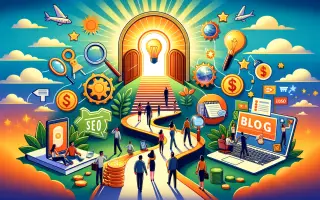Are you tired of staring at a blank screen, wondering how to craft that perfect email?
Well, I’m here to introduce you to a game-changer in the world of email writing – ChatGPT!
What Is ChatGPT?
Before we jump into the nitty-gritty of email writing, let’s quickly understand what ChatGPT is. ChatGPT is an advanced AI language model developed by OpenAI. It’s designed to understand and generate human-like text, making it an incredible tool for various natural language processing tasks, including email writing.
With ChatGPT, you can receive suggestions, generate content, and even engage in a conversation – all through text-based interactions.
Now, let’s get down to business and explore how you can leverage ChatGPT for effective email writing!
Step 1: Define Your Email’s Purpose
The first rule of writing a great email, with or without AI, is to be clear about your email’s purpose.
Are you reaching out for a job application, seeking advice, making a sales pitch, or just saying hello?
Knowing your goal will help you frame the content effectively.
With ChatGPT, you can simply state your purpose, and it will generate a draft for you.
1.1 Determine Your Email’s Goal:
Before you begin writing your email, you should have a clear understanding of your email’s primary objective.
Ask yourself questions like:
- What do I want to accomplish with this email?
- What action do I want the recipient to take after reading it?
- What message or information do I need to convey?
The purpose of your email could be one of many things, such as:
- Requesting Information: You might be seeking information or clarification from the recipient.
- Making a Sales Pitch: If you’re in sales, your goal might be to persuade the recipient to purchase your product or service.
- Sending a Job Application: If you’re job hunting, you’re aiming to impress potential employers and secure an interview.
- Expressing Gratitude: Sometimes, you might just want to say “thank you” or show appreciation.
- Sharing Information: You might be sending an update, news, or important information to colleagues or clients.
1.2 Frame Your Email’s Content:
Once you’ve identified your email’s purpose, you can frame the content accordingly. For example:
- If you’re requesting information, your email should be polite, clear, and concise. Make it easy for the recipient to respond.
- If you’re making a sales pitch, focus on the benefits of your product or service. Address the recipient’s pain points and explain how your offering can solve their problems.
- If you’re sending a job application, your email should highlight your qualifications, enthusiasm for the position, and why you’re a good fit.
- If you’re expressing gratitude, be sincere and specific about what you’re thankful for.
- If you’re sharing information, organize your content logically and make sure it’s relevant to the recipient.
1.3 How ChatGPT Helps:
Now, here’s where ChatGPT comes into play. Instead of starting with a blank slate, you can use ChatGPT to assist you in generating the initial draft based on your defined purpose. For instance:
- If your purpose is to request information, you can ask ChatGPT to help you draft an inquiry email by specifying the context and details.
- If you’re making a sales pitch, you can provide ChatGPT with information about your product or service and ask it to suggest compelling content.
- If you’re writing a job application, you can give ChatGPT your qualifications and the job description, and it can assist in crafting a convincing application email.
- If you’re expressing gratitude, you can ask ChatGPT for help in composing a heartfelt thank-you message.
- If you’re sharing information, you can outline the key points you want to include and ask ChatGPT to assist in writing a clear and informative email.
ChatGPT can be your creative partner, helping you kickstart your email writing process by providing suggestions and ideas aligned with your email’s purpose.
Remember, while ChatGPT can assist in generating content, your personal touch and customization are essential to make the email more genuine and tailored to the recipient. So, always review and refine the draft generated by ChatGPT to ensure it aligns perfectly with your communication goals.
Step 2: Create an Attention Grabbing Subject Line
Your subject line is like the opening act of a great email. It needs to grab the recipient’s attention and make them want to open your email. ChatGPT can help you brainstorm creative and attention-grabbing subject lines.
Here’s how you can do it:
“Hey ChatGPT, I need a catchy subject line for an email about our upcoming product launch.”
You’ll be amazed at the intriguing subject lines ChatGPT can generate. Just pick the one that suits your email best, and you’re off to a great start!
Step 3: Personalize Your Greeting
“Personalize Your Greeting,” is an important aspect of effective email writing. A personalized greeting can set the tone for your email, establish a connection with the recipient, and make your communication feel more genuine.
Let’s look deeper into this step:
3.1 The Importance of Personalization:
Personalization is about addressing the recipient by their name or using a greeting that resonates with the specific context of your email. It’s crucial because it shows that you’ve taken the time to consider the individual you’re reaching out to, rather than sending a generic message.
A personalized greeting can make your email:
- Engaging: It captures the recipient’s attention and makes them more likely to continue reading.
- Respectful: It shows that you value the recipient as an individual and not just another contact on your list.
- Relevant: It ensures that your email feels tailored to the recipient’s needs or interests.
3.2 How to Personalize Your Greeting:
Here are a few ways to personalize your greeting effectively:
- Use the Recipient’s Name: If you have the recipient’s name, it’s often best to use it. For example: “Hi [Recipient’s Name],” or “Dear [Recipient’s Name],”
- Reference a Shared Experience or Interest: If you share a common interest or have recently interacted in a particular context, acknowledge it. For instance, “I enjoyed our discussion at the conference last week.”
- Recognize Their Role or Position: If you’re writing to a professional contact, acknowledging their job role or position can show that you’ve done your homework. For example: “Hello, Marketing Director,” or “Dear [Recipient’s Job Title],”
- Show Empathy: If the recipient is going through a challenging time or you know they’ve recently faced a difficulty, expressing empathy in your greeting can be thoughtful. For example: “I hope you’re doing well despite the recent challenges.”
3.3 How ChatGPT Can Help:
ChatGPT can assist you in personalizing your greeting by suggesting appropriate greetings based on the context you provide. For example:
- If you’re writing to a potential client, you can ask ChatGPT, “Hey ChatGPT, I’m writing an email to a potential client. How should I greet them?” ChatGPT can provide suggestions that suit a professional context.
- If you’re reaching out to a colleague after a successful project, you can provide ChatGPT with details about the project and ask for a warm and friendly greeting.
- If you have a specific shared interest or context with the recipient, you can mention it to ChatGPT and ask for a greeting that acknowledges that connection.
ChatGPT can offer creative and context-aware suggestions to make your greeting more personalized and engaging. However, it’s essential to review and adjust these suggestions to ensure they align with your relationship with the recipient and the overall tone of your email.
Remember that personalization doesn’t stop at the greeting; it should extend throughout your email to create a meaningful and tailored communication experience for the recipient.
Step 4: Body of the Email
Now comes the meat of your email – the body. Here’s where ChatGPT can be a real lifesaver. Whether you need to explain a complex idea, highlight the benefits of your product, or tell a compelling story, ChatGPT can assist you in putting your thoughts into words.
For instance:
“Hey ChatGPT, I’m writing an email to inform our team about the upcoming project. Can you help me draft the body of the email?”
ChatGPT can generate content based on your input, making the writing process smoother and more efficient.
Step 5: Proofreading and Editing
Once you’ve written your email, it’s essential to proofread and edit it for clarity, grammar, and tone. ChatGPT can serve as your virtual editor, providing suggestions and corrections as needed.
“Hey ChatGPT, can you review my email and suggest any improvements in terms of grammar and tone?”
ChatGPT will analyze your text and offer valuable insights to enhance the quality of your email.
Step 6: Polishing Your Closing
A strong closing leaves a lasting impression. Whether you want to express gratitude, set expectations, or prompt a specific action, ChatGPT can help you craft the perfect closing statement.
“Hey ChatGPT, I need a closing statement for my email to a potential investor. Can you help?”
ChatGPT can suggest closings that align with your email’s purpose and tone, making your email more persuasive.
Step 7: Signature and Contact Information
Don’t forget to include your signature and contact information. ChatGPT can generate a professional signature for you. Just provide the necessary details:
“Hey ChatGPT, can you create a signature for my email? Here’s my name, job title, and contact information.”
ChatGPT will format a signature that looks polished and includes all the essential information.
Step 8: Review and Send
Before hitting that “send” button, take a moment to review the entire email. Make sure it flows logically, conveys your message effectively, and maintains a consistent tone. ChatGPT can help you fine-tune any last-minute changes.
Tips for Successful Email Writing with ChatGPT
Now that you know how to use ChatGPT for effective email writing, here are some additional tips to keep in mind:
1. Be Specific in Your Requests
When interacting with ChatGPT, be specific in your requests. The more precise your instructions, the better the AI can assist you. Instead of saying, “Help me with my email,” specify your email’s purpose or the type of content you need.
2. Edit and Personalize
While ChatGPT can provide excellent content suggestions, always remember to add a personal touch and tailor the email to your recipient. Customize the content to make it more genuine and relatable.
3. Keep It Professional
ChatGPT can be playful, but remember that professionalism matters, especially in business emails. Maintain a tone that matches the context and your audience’s expectations.
4. Verify Information
Double-check any facts, figures, or details provided by ChatGPT. While the AI is powerful, it’s still essential to ensure the accuracy of the information in your email.
5. Practice and Learn
The more you use ChatGPT for email writing, the better you’ll become at leveraging its capabilities effectively. Practice makes perfect, so don’t hesitate to experiment and learn from your interactions.
Wrapping Up
Using ChatGPT for effective email writing can save you time, reduce writer’s block, and help you craft compelling emails that get results. Whether you’re a professional or just looking to enhance your email-writing skills, ChatGPT is a valuable tool in your arsenal.
So, give it a try!
Experiment with ChatGPT, and let your creativity flow as you compose engaging emails that leave a lasting impression. With a bit of practice and a touch of AI magic, your inbox will be filled with positive responses, and your email writing game will be stronger than ever.
Now get atta here, and conquer those emails like the email-writing pro you were meant to be!




